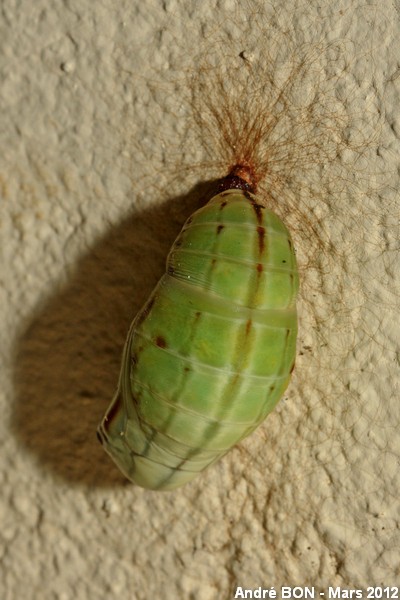


| Brassolis sophorae (Linnaeus, 1758) |



|
|
Scientific name: Brassolis sophorae (Linnaeus, 1758) Common name: French name: Order: Lepidoptera Suborder: Rhopalocera Family: Nymphalidae Subfamily: Morphinae Wingspan: 70 to 80 mm for males; 90 to 105 mm for females. Biotope: Parks, gardens, cultivated areas with presence of the host plants. Geographic area: South America, from Venezuela to Argentina, including Trinidad. Flight time: Number of generations : The development cycle from the egg to the adult state lasts about 100 days. Caterpillar: Hairless, from reddish brown to dark green with two lateral pale brown stripes. The head is dark reddish brown with two black spots. The caterpillars are gregarious and gather during the day in large silk retreats. They go out at night to feed. Host plant: Mainly on Palmae, palm trees and coconut trees, but also on sugar canes, on banana trees and on many other plants. |
Brassolis sophorae is a large brown butterfly. The fore wings show a broad yellow diagonal band. This band splits into two stripes next to the costal edge on females to form a Y-shaped mark. There are several subspecies on which the diagonal band varies in colour and may include some white parts. Colonies of caterpillars can cause very important damages to the host plants. |
| [To know more about the Brassolis sophorae] [Next picture] [Top] |

|
I have observed this large chrysalis in a washing machine shelter located in a garden in Rémire-Montjoly. |
| [To know more about the Brassolis sophorae] [Next picture] [Previous picture] [Top] |

|
There is one banana tree which is very close, and it was perhaps used as a host plant. I have not seen any evident damage and I even enjoyed eating some very delicious bananas during my short stay there. |
| [To know more about the Brassolis sophorae] [Previous picture] [Top] |

|
Back to the "base camp" four days later, I had the pleasure to observe the imago just emerged out of its chrysalis. |